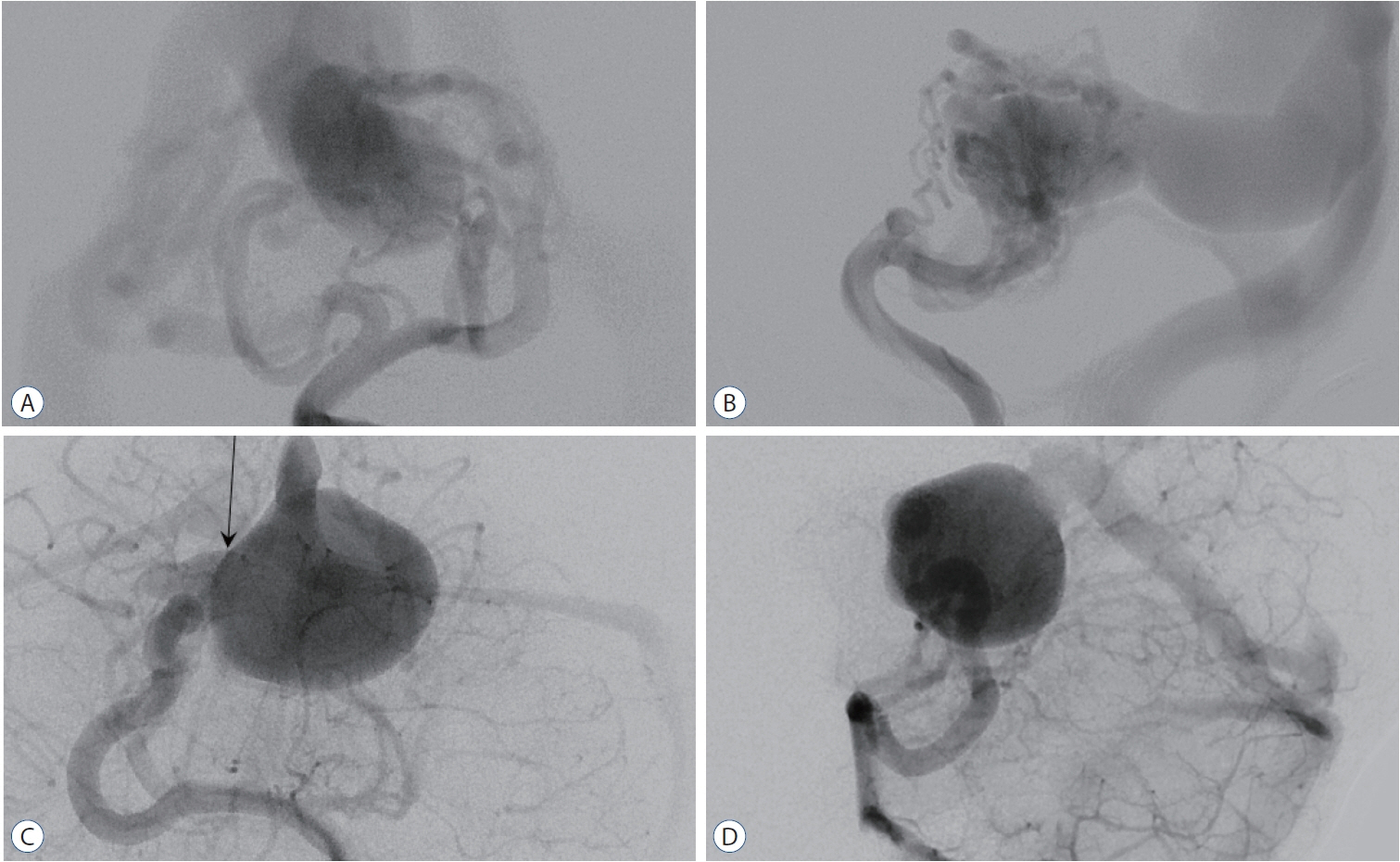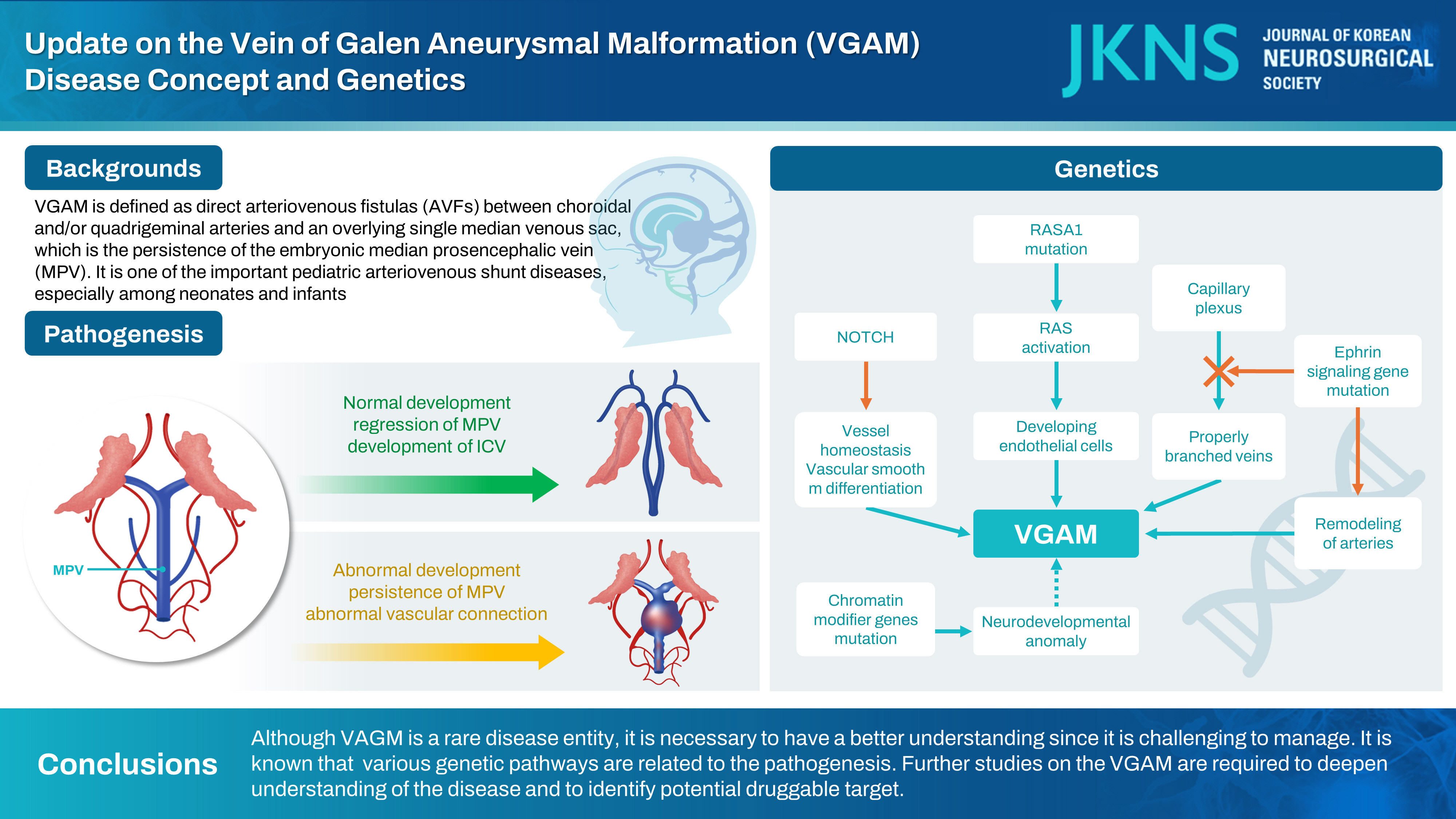J Korean Neurosurg Soc.
2024 May;67(3):308-314. 10.3340/jkns.2024.0058.
Update on the Vein of Galen Aneurysmal Malformation : Disease Concept and Genetics
- Affiliations
-
- 1Department of Neurosurgery, Seoul National University Hospital, Seoul National University College of Medicine, Seoul, Korea
- KMID: 2554868
- DOI: http://doi.org/10.3340/jkns.2024.0058
Abstract
- Vein of Galen aneurysmal malformation is one of important pediatric arteriovenous shunt diseases, especially among neonates and infants. Here, early history of the disease identification, basic pathoanatomy with a focus on the embryonic median prosencephalic vein, classification and differential diagnoses, and recent genetic studies are reviewed.
Figure
Cited by 1 articles
-
Editors’ Pick in May 2024
Hee-Jin Yang
J Korean Neurosurg Soc. 2024;67(3):259-260. doi: 10.3340/jkns.2024.0089.
Reference
-
References
1. Alpers BJ, Forster FM. Arteriovenous aneurysm of great cerebral vein and arteries of circle of Willis; formation by junction of the great cerebral vein and the straight sinus and by the choroidal arteries and anomalous branches of the posterior cerebral arteries. Arch Neurol Psychiatry. 54:181–185. 1945.
Article2. Amyere M, Revencu N, Helaers R, Pairet E, Baselga E, Cordisco M, et al. Germline loss-of-function mutations in EPHB4 cause a second form of capillary malformation-arteriovenous malformation (CM-AVM2) deregulating RAS-MAPK signaling. Circulation. 136:1037–1048. 2017.
Article3. Bhattacharya JJ, Thammaroj J. Vein of Galen malformations. J Neurol Neurosurg Psychiatry. 74(Suppl 1):i42–i44. 2003.
Article4. Boldrey E, Miller ER. Arteriovenous fistula (aneurysm) of the great cerebral vein (of Galen) and the circle of Willis; report on two patients treated by ligation. Arch Neurol Psychiatry. 62:778–783. illust. 1949.
Article5. Campi F, De Rose DU, Pugnaloni F, Ronci S, Calì M, Pro S, et al. Neurodevelopmental and genetic findings in neonates with intracranial arteriovenous shunts: a case series. Front Pediatr. 11:1111527. 2023.
Article6. Chida A, Shintani M, Wakamatsu H, Tsutsumi Y, Iizuka Y, Kawaguchi N, et al. ACVRL1 gene variant in a patient with vein of Galen aneurysmal malformation. J Pediatr Genet. 2:181–189. 2013.7. Dandy WE. Arteriovenous aneurysm of the brain. Arch Surg. 17:190–243. 1928.
Article8. Duran D, Zeng X, Jin SC, Choi J, Nelson-Williams C, Yatsula B, et al. Mutations in chromatin modifier and ephrin signaling genes in vein of Galen malformation. Neuron. 101:429–443.e4. 2019.
Article9. Fattah M, Raman MM, Reiss AL, Green T. PTPN11 mutations in the RasMAPK signaling pathway affect human white matter microstructure. Cereb Cortex. 31:1489–1499. 2021.
Article10. Gailloud P, O’Riordan DP, Burger I, Lehmann CU. Confirmation of communication between deep venous drainage and the vein of Galen after treatment of a vein of Galen aneurysmal malformation in an infant presenting with severe pulmonary hypertension. AJNR Am J Neuroradiol. 27:317–320. 2006.11. Gerety SS, Wang HU, Chen ZF, Anderson DJ. Symmetrical mutant phenotypes of the receptor EphB4 and its specific transmembrane ligand ephrin-B2 in cardiovascular development. Mol Cell. 4:403–414. 1999.
Article12. Hamilton MG, Herman JM, Khyata MH, Spetzler RF. Aneurysms of the vein of Galen. In : Youmans JR, editor. Youmans Neurological Surgery. ed 4. Philadelphia: W.B. Saunders;1996. Vol 2:p. 1491–1510.13. Heuchan AM, Joss S, Berg J, Suri M, Bhattacharya J. G25 RASA1 mutations and vein of Galen arterial malformation. Arch Dis Child. 98(Suppl 1):A16–A17. 2013.14. Jaeger JR. Bilateral congenital cerebral arteriovenous communication aneurysm. Trans Am Neurol Assoc. 63:173–176. 1937.15. Jaeger R, Forbes RP. Bilateral congenital arteriovenous communications (aneurysm) of the cerebral vessels. Arch Neurol Psychiatry. 55:591–599. 1946.
Article16. Johnston IH, Whittle IR, Besser M, Morgan MK. Vein of Galen malformation: diagnosis and management. Neurosurgery. 20:747–758. 1987.
Article17. Joutel A, Corpechot C, Ducros A, Vahedi K, Chabriat H, Mouton P, et al. Notch3 mutations in CADASIL, a hereditary adult-onset condition causing stroke and dementia. Nature. 383:707–710. 1996.
Article18. Kofler NM, Cuervo H, Uh MK, Murtomäki A, Kitajewski J. Combined deficiency of Notch1 and Notch3 causes pericyte dysfunction, models CADASIL, and results in arteriovenous malformations. Sci Rep. 5:16449. 2015.
Article19. Komiyama M. The median vein of prosencephalon of Markowski: from morphology to genetics. Interv Neuroradiol. 26:752–756. 2020.
Article20. Lasjaunias P, Rodesch G, Terbrugge K, Pruvost P, Devictor D, Comoy J, et al. Vein of Galen aneurysmal malformations. Report of 36 cases managed between 1982 and 1988. Acta Neurochir (Wien). 99:26–37. 1989.21. Lasjaunias P, ter Brugge KG, Berenstein A. Surgical Neuroangiography. ed 2. Berlin: Springer-Verlag;2006. Vol 3:p. 105–226.22. Lawson ND, Scheer N, Pham VN, Kim CH, Chitnis AB, Campos-Ortega JA, et al. Notch signaling is required for arterial-venous differentiation during embryonic vascular development. Development. 128:3675–3683. 2001.
Article23. Levrier O, Gailloud PH, Souei M, Manera L, Brunel H, Raybaud C. Normal galenic drainage of the deep cerebral venous system in two cases of vein of Galen aneurysmal malformation. Childs Nerv Syst. 20:91–97. discussion 98-99. 2004.
Article24. Oscherwitz D, Davidoff LM. Midline calcified intracranial aneurysm between occipital lobes; report of a case. J Neurosurg. 4:539–541. 1947.25. Raybaud CA, Strother CM, Hald JK. Aneurysms of the vein of Galen: embryonic considerations and anatomical features relating to the pathogenesis of the malformation. Neuroradiology. 31:109–128. 1989.
Article26. Revencu N, Boon LM, Mendola A, Cordisco MR, Dubois J, Clapuyt P, et al. RASA1 mutations and associated phenotypes in 68 families with capillary malformation-arteriovenous malformation. Hum Mutat. 34:1632–1641. 2013.
Article27. Revencu N, Boon LM, Mulliken JB, Enjolras O, Cordisco MR, Burrows PE, et al. Parkes Weber syndrome, vein of Galen aneurysmal malformation, and other fast-flow vascular anomalies are caused by RASA1 mutations. Hum Mutat. 29:959–965. 2008.
Article28. Russell DS, Nevin S. Aneurysm of the great vein of Galen causing internal hydrocephalus: report of two cases. J Path Bact. 51:375–383. 1940.
Article29. Singh A, Saini N, Behl G, Aggarwal S, Kolar G. Recurrent vein of Galen aneurysmal malformation as a presentation of hereditary hemorrhagic telangiectasia. Mol Syndromol. 13:440–446. 2022.
Article30. Tsutsumi Y, Kosaki R, Itoh Y, Tsukamoto K, Matsuoka R, Shintani M, et al. Vein of Galen aneurysmal malformation associated with an endoglin gene mutation. Pediatrics. 128:e1307–e1310. 2011.
Article31. Wang HU, Chen ZF, Anderson DJ. Molecular distinction and angiogenic interaction between embryonic arteries and veins revealed by ephrin-B2 and its receptor Eph-B4. Cell. 93:741–753. 1998.
Article32. Yamakawa N, Tsuchida K, Sugino H. The rasGAP-binding protein, Dok1, mediates activin signaling via serine/threonine kinase receptors. EMBO J. 21:1684–1694. 2002.
Article33. Yasargil MG. Microneurosurgery. ed 1. New York: Thieme;1988. Vol IIIB:p. 323–357.34. Zhao S, Mekbib KY, van der Ent MA, Allington G, Prendergast A, Chau JE, et al. Mutation of key signaling regulators of cerebrovascular development in vein of Galen malformations. Nat Commun. 14:7452. 2023.
Article
- Full Text Links
- Actions
-
Cited
- CITED
-
- Close
- Share
- Similar articles
-
- True Aneurysmal Malformation of Vein of Galen: Case Report
- Vein of Galen Aneurysmal Malformation: Treatment by Transarterial Venous Sac and Fistula Embolization Using Coils and Glue
- Transarterial Embolization with Berenstein Liquid Coils and N-butyl Cyanoacrylate in a Vein of Galen Aneurysmal Malformation: a Case Report
- A case of the vein of Galen malformation
- Morphometric evaluation of great vein of Galen and its clinical implications



